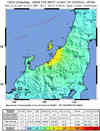Magnitude 6.6 - NEAR THE WEST COAST OF HONSHU, JAPAN
2007 July 16 01:13:22 UTC
Earthquake Details
| Magnitude | 6.6 |
|---|---|
| Date-Time |
|
| Location | 37.576°N, 138.469°E |
| Depth | 10 km (6.2 miles) set by location program |
| Region | NEAR THE WEST COAST OF HONSHU, JAPAN |
| Distances | 70 km (45 miles) WSW of Niigata, Honshu, Japan 105 km (65 miles) N of Nagano, Honshu, Japan 145 km (90 miles) NNW of Maebashi, Honshu, Japan 245 km (150 miles) NNW of TOKYO, Japan |
| Location Uncertainty | horizontal +/- 5.5 km (3.4 miles); depth fixed by location program |
| Parameters | NST=285, Nph=285, Dmin=935.6 km, Rmss=1.11 sec, Gp= 25°, M-type=moment magnitude (Mw), Version=9 |
| Source |
|
| Event ID | us2007ewac |
- This event has been reviewed by a seismologist.
- Did you feel it? Report shaking and damage at your location. You can also view a map displaying accumulated data from your report and others.
Earthquake Summary
The following is a release by the United States Geological Survey, National Earthquake Information Center: An earthquake occurred NEAR THE WEST COAST OF HONSHU, JAPAN, about 70 km (45 miles) WSW of Niigata or 245 km (155 miles) NNW of TOKYO at 7:13 PM MDT, Jul 15, 2007 (Jul 16 at 10:13 AM local time in Japan). The magnitude and location may be revised when additional data and further analysis results are available.
Felt Reports
Nine people killed, at least 1,088 injured, 875 houses damaged, roads and bridges damaged and landslides occurred in Nagano, Niigata and Toyama Prefectures. A two-car train derailed on the JR Echigo Line at Kashiwazaki. A minor tsunami was observed on Sadoga-shima. Felt (IV) at Niigata and (III) at Tokyo. Recorded (6U JMA) in Nagano and Niigata; (5L JMA) in Ishikawa; (4 JMA) in Fukushima, Gumma, Ibaraki, Saitama, Tochigi and Yamagata; (3 JMA) in Aichi, Chiba, Gifu, Kanagawa, Miyagi, Shizuoka, Tokyo, Toyama and Yamanashi; (2 JMA) in Akita, Fukui, Hyogo, Iwate, Kyoto, Mie, Nara, Osaka and Shiga; (1 JMA) in Aomori, Tottori and Wakayama Prefectures.
Tectonic Summary
This magnitude 6.6 earthquake occurred near the west coast of Honshu, Japan, in a zone of compressional deformation that is associated with the boundary between the Amur plate and the Okhotsk plate. At this latitude, the Okhotsk plate is converging to the west-northwest towards the Amur plate with a velocity of about 9 mm/yr. The Amur and Okhotsk plate are themselves relatively small plates that lie between the Eurasia plate and the Pacific plate. The Pacific plate converges west-northwest towards the Eurasia plate at over 90 mm/yr. Most of the relative motion between the Pacific plate and the Eurasia plate is accommodated approximately 400 km to the east-southeast of the epicenter of the earthquake, where the Pacific plate subducts beneath the Okhotsk plate.
This shallow crustal earthquake was followed 13 hours later by a deep focus magnitude 6.8 quake roughly 330 km to the west, 350 km below the Sea of Japan. The two earthquakes were generated by different mechanisms. The first earthquake was caused by deformation within the crust of the Okhotsk plate and the second quake was likely caused by faulting resulting from internal deformation of the subducted Pacific plate. Given their different mechanisms and physical separation of at least 10 rupture lengths, the second earthquake is not considered an aftershock of the first.
Shallow earthquakes cause more damage than intermediate- and deep-focus ones since the energy generated by the shallow events is released closer to the surface and therefore produces stronger shaking than is produced by quakes that are deeper within the Earth.
Other deadly earthquakes have occurred in this region: In 2004, a magnitude 6.6 earthquake occurred in the Niigata Prefecture, 50 km to the southeast of the recent quake, killing 40 people and injuring about 3,000. In June, 1964, a M7.5 earthquake occurred about 115 km to the north-northeast of the recent quake, killing 37 people; and in April, 1995 a M5.4 earthquake 70 km to the northeast injured at least 39 people.
During the 20th century Japan has suffered nine devastating earthquakes that killed more that 1000 people each. Among these are the 1923 M7.9 earthquake that triggered the great Tokyo fire that killed 143,000 people and the more recent 1995 M6.9 Kobe earthquake that killed about 5,500 people.
Earthquake Maps
Scientific & Technical Information
- Preliminary Earthquake Report
- U.S. Geological Survey, National Earthquake Information Center:
World Data Center for Seismology, Denver

 Feeds & Data
Feeds & Data









